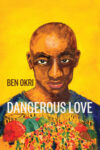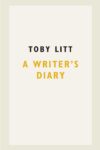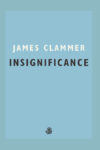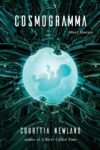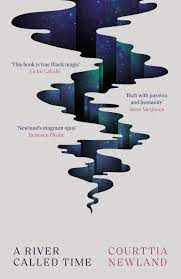
[Canongate; 2021]
Towards the end of the 1990’s, the success of writer Diran Adebayo’s Some Kind of Black, and Courttia Newland’sThe Scholar, broke new ground in British fiction. Their honest portrayals of young Black Londoners, all but unknown to British literature at the time, offered Black British readers a rare opportunity to see their lives and experiences reflected in books. Over the course of a further five novels and numerous plays, Newland has continued to document Black British life while experimenting with his approach, hopping between genre and style. And his most recent work, A River Called Time — a speculative, African cosmology fantasy — is, once again, surprising. Twenty years in the making, this ambitious passion project was, as Newland explains in the afterword, a difficult sell. “I was told I should stick to writing urban stories; that ‘mysticism’ was the antithesis of speculative fiction; and best of all, that Black people didn’t eat spaghetti bolognese.” Eventually, rumours of Newland’s big science fiction novel began circulating and thankfully, it found a home.
In the alternative history A River Called Time writes, the spiritualist beliefs of Ancient Egypt have retained dominance over the modern world and Europeans arrive on the continent of Africa, not to colonise, but in search of wisdom. There was no international slave trade, no Windrush, no mother country. In Newland’s radical forking of time, London is known as Dinium, a ravaged city whose radiated centre has been left uninhabitable by a War of Light. The outer suburbs, their sky like “soup-like mist”, are deprived and polluted. On the site of the scorched, inner city land stands The Ark — a self enclosed, city-sized mega structure which took 80 years to build and is considered a modern wonder of the world. The Ark provides clean air, artificial light and a comfortable living for its residents. It is a five star refuge for Dinium’s most successful and wealthy citizens, constructed and seemingly controlled by the omnipotent E-Lul technology company.
Throughout the book, the reader follows Markriss Denny, a young boy from the outer suburbs who has an unusual power, one that allows his soul to separate from his body and float above his physical form. Markriss gains entry to The Ark on a scholarship, but life in The Ark is not the affluent haven presented to the outside world. In fact, it is a technocratic state, marred by social inequality, rioting, and police brutality. As the novel moves into a future time, Markriss becomes a journalist for Ark Light, where the reporters’ “opinions were worthless” and their content “controlled by higher bodies” — by E-Lul. Meanwhile, E-Lul have released futuristic sleep pods that allow citizens to plug themselves in and experience ‘projected simulation’, supposedly to maintain peace and tranquility. It was in a sleep pod that Markriss’ younger brother, Ninka, died, when they were small. They were both asleep, being fed online projections when Markriss was suddenly thrown into a powerful, transmutational state. Moments later Ninka stopped breathing. Although the cause of death was never clarified, Markriss always wondered if it was his fault that his powers had caused it. As a result, Markriss chooses not to connect to a sleep pod and struggles with insomnia. Keshni, a colleague and love interest, shows him a way to naturally transmutate, offline, without the need for a sleep pod.
In this state of transmutation, Markriss’ ethereal form travels through astrally projected planes where he is met by a guide, a spiritual ancestor and expert in Kemetic science, who informs Markriss of his ability of duality. This knowledge allows Markriss to re-enter the physical realm in a parallel time, where different decisions have created multiple realities. Due to ‘events in the higher realms’, Markriss has been contacted to carry out a mission only he can perform. In one particular world, a dangerous spirit known as The Rogue has occupied the body of Markriss’s friend. The Rogue also has the power of duality and may destroy the physical world. In accordance with the Kemetic Laws of Maat, Markritt is compelled to kill The Rogue. At some point, The Rogue will inhabit The Ark at a very high level, this is a pre-emptive act. The code of ancient African cosmology does not allow evil to create an imbalance, it must be stopped by any means. The ethics of killing The Rogue are clear, it is the Law, and as such, contains moral certainty. Newland is forcing readers to ask the same question of themselves — if you knew evil lay ahead, would you go back and remove it? Moreover, should it be enshrined in law to do so?
If cosmologically explained multi-verses where souls traverse spiritual planes all sound like a fantastical plunge too far, rest assured, Newland’s storytelling is far from nebulous. Just like in Orwell’s 1984, at the heart of Newland’s dystopia is a love story. Across parallel time, Markriss’ feelings for two women, Keshni and Chileshe, often guide him. In one timeline, when he is a rebel attempting to bring down the E-Lul corporation Markriss is in a loving marriage to Chileshe. In another, he falls for Keshni while Chileshe remains a good friend. His feelings for both women appear to be, in part, informed by the concurrent lives he is living — a mystical bond passed unknowingly from one realm to another. By revealing the potentialities of the universe, Newland proposes a universe with no overriding destiny at play. Markriss falls in love with Chileshe and Keshni, in parallel time. Newland is providing a clear message — societies are a reflection of choice, not an inevitable consequence of time. Like history, love is a construct, built differently each time. The complexities of Markriss’ relationships is a smart, emotional counterpoint to the world of The Ark, mirroring its hope and missed opportunities. By telling a story through parallel universes, the future and the past become inseparable, allowing A River Called Time to be both visionary and reflective all at once.
In Newland’s meticulously imagined, decolonised world, free from legacies of slavery and systemic racism, society remains deeply divided and violent. Climate catastrophe, controlled media, big tech domination, mental health crises, drug culture, police violence, mass protests, all suggest a gloom ridden prophecy, stemming from a divergent history that may one day taper to meet our own. Yet, the force of A River Called Time’s central conceit is most powerfully encapsulated in its third part, when Markriss is shown not in an imaginary world, but our existing reality. It is November 2019, Markriss is in London, and for the first time, being a Black man matters as, suddenly, the reader witnesses Markriss’ life unavoidably entwined and informed by his race. A simple tube journey is flecked with tension, newspaper headlines, art exhibitions, political wranglings, are characterised by race. Watching a movie with Chileshe is a reminder to Markriss, of the gnawing, colonial heritage that has informed his life since childhood. They share stories of their experiences, conversations they would never have in Dinium. There is so much to admire in Newland’s invented Dinium, from its application of Kemetic science, re-wiring minds and institutions, to the adaptation of a new lexicon and the reassessment of cultural norms and practices. Yet, it is through witnessing Markriss live an ordinary life in London, experiencing a sudden brush with reality, that seems most shocking. By switching the narrative from a fantasy setting to the realm of urban realism, Newland not only reveals the hidden messages and reverberations of a society steeped in a history of racism, but he clarifies one the key points of the novel — that to remove Africa’s colonialisation and the international slave trade from time, would not create a fair and equal society, far from it. Dinium and London’s differences are not only historical but psychological. It is a reminder that the progress of a society looks one way from the outside and feels another, from within.
A River Called Time offers readers their own out of body experience; they get to float above the surface and peer down at reality, re-examine the way history can determine life, impose an eventuality. Newland’s meticulously drawn characters and bright, vivid description gives voice to humanity alongside ideas. Whether in London or Dinium, Markriss and his friends fight for survival, maintaining the desire to create a better world, in their own, often different ways. By telling the story of many lives and many histories, Newland warns of the dangers of both a perilous future and a shameful past.
Simon Lowe is a British writer and journalist. His stories have appeared in Breakwater Review, AMP, Storgy, Firewords, Ponder review, and elsewhere. He has written articles about books and society for the Guardian and BBC worldwide. His new novel, The World is at War, Again, will be published in 2021 (Elsewhen Press).
This post may contain affiliate links.




